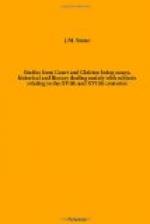Cotton and Bodley were good friends, and not only shared the same tastes, but sympathised actively with each other’s work. In 1595 Bodley wrote to Cotton, asking him whether he held to his “old intention for helping to furnish the Universitie librarie,” and in 1601 he acknowledges having received from Cotton a contribution of manuscripts for that purpose. These manuscripts were eleven in number, the titles of which may be seen in Smith’s manuscript notes to his catalogue in the Bodleian library.
Bodley on his part was no less generous. A folio volume on vellum, containing the four Gospels, the four Dialogues of St. Gregory, and some other articles, the whole in Saxon, and consisting of 290 leaves, was a part of his contribution to the Cottonian collection.* The contents of this volume, as described by Wanley, show it to have been of exceeding great value, but since his time twenty-five folios have been lost. When Planta compiled his catalogue he affixed a note to the effect that the manuscript was so burnt and contracted as to render the binding of it impracticable, and that it was preserved in a case. Later on it passed through the restoring hands of Sir Frederick Madden.
* Otho, C. i. The notes furnished by Smith also prove the identity of the Cotton Ms. Otho, C. ix. with Bodley’s gift.
Cotton was neither a great scholar, nor did he produce any original work of special value, but he seems to have possessed the tact and the taste to divine, and also encourage talents superior to his own, thereby deserving no less well of his country than those who served her with higher gifts. His friend Gondomar, the Spanish ambassador, once called him an “engrosser of antiquities.” If we add that he did not merely “engross,” but that he liberally shared his acquisitions with others, we shall perhaps best describe his special place and work in the world of letters. To judge by his correspondence it would seem that all the learned men in the kingdom applied to him for the loan of some rare manuscript or other, and that hardly a scientific, political, historical, or heraldic work was produced in the early part of the seventeenth century, but owed something to his labours as an antiquary.
Selden asks for a sight of his Peterborough books, his Book of Monies his Historic Jorwallensis. Camden writes for a treatise on Heraldry, and for a ledger of the Abbey of Meaux. George Carew, afterwards Earl of Totness, needs his Chronicle of Peter the Cruel. Crashaw, the poet, sends for volumes treating of the Council of Florence, and of the excommunication of the emperor at the Council of Lyons. Sir John Dodderidge, judge and antiquary, asks leave to keep Cotton’s maps (perhaps for his work “Of the Dimensions of the Land of England"). Speed requires a note of all the monasteries in the realm, as well as the Book of Henry iv., and craves help in his Life of Henry V., signing himself “Your loving friend, troublesome and troubled.”




